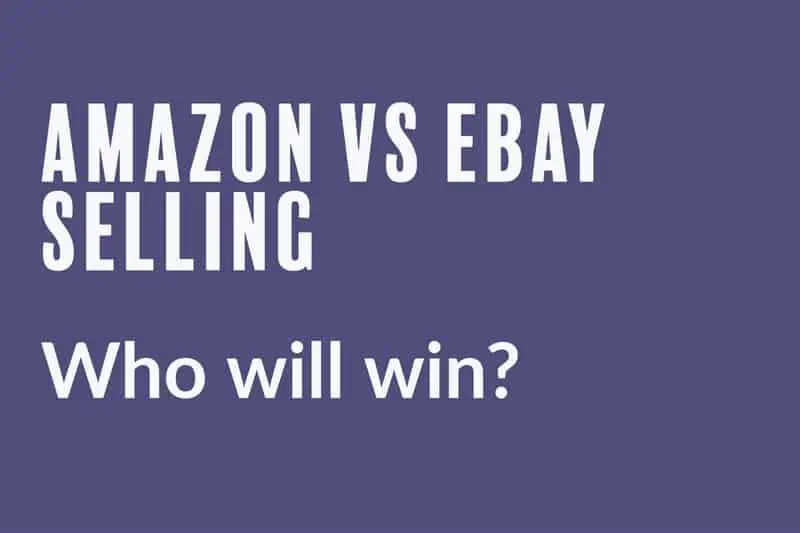What you’ll learn
It’s the ultimate showdown: Amazon and eBay, two titans of e-commerce, face off in a battle that will shape the future of online selling. Who will be crowned champion? Or is this an all-too-familiar story with no clear victor?
I’m here to provide answers and analysis into who will emerge triumphant from this epic struggle.
The dawn of digital commerce has ushered in a new era for buyers and sellers alike – one where traditional retail shopping takes a backseat to convenience and speed.
But it’s also created a world where competition between marketplaces is fierce, leaving consumers searching for the platform that offers them the best value.
At stake are billions of dollars in transaction fees, making understanding the differences between Amazon and eBay more important than ever before.
Both companies have been around since the mid-90s, but they offer vastly different experiences when it comes to buying and selling products online. From product selection to customer service to payment options, these two juggernauts have gone head-to-head in an attempt to capture customers’ attention – and wallet share.
So which marketplace reigns supreme? Let’s dig into their respective offerings so we can answer that question once and for all!

Overview Of Platforms
It’s no secret that Amazon and eBay are two of the most popular online platforms for sellers. It’s important to understand how each platform works in order to determine which is the optimal option for individual businesses.
When comparing Amazon vs. eBay selling, both have advantages and disadvantages when it comes to fees, services offered, and overall convenience.
The eBay website has been around since 1995, making them one of the oldest players on the market. They charge a flat-rate fee per item listed as well as a percentage commission based on the final sale price.
This model can be beneficial for those who prefer predictable costs upfront, so they know exactly what their bottom line will look like. On top of this, eBay has many features tailored specifically towards small business owners, such as access to detailed analytics reports and promotional tools.
When compared with eBay, Amazon offers more automated options but also charges additional fees depending on the category or product type sold.
For example, Fulfillment by Amazon (FBA) services include storage, shipping, and customer service support – all taken care of by Amazon themselves – at a lower cost than third-party fulfillment companies usually offer.
The downside is that sellers must pay extra for these services along with monthly subscription fees or referral fees if applicable. Additionally, some categories require approval from Amazon before listing products due to potential legal issues related to those items being sold online.
Both platforms provide great opportunities for online sellers looking to reach shoppers quickly; however, certain factors must be considered before choosing between them.
In weighing up the pros and cons, such as fee structure, available services, and overall ease of use, merchants should select the right platform according to their individual needs and goals to maximize profits while minimizing the effort required.
Fee Structures
The battle between Amazon and eBay selling is an ongoing war of attrition that has been going on for years. At the center of this fight are their respective fee structures, which can be a major deciding factor in who will come out on top in this ultimate showdown.
Let’s take a closer look at what each platform has to offer:
- Amazon Selling Fees – Sellers pay a referral fee ranging from 8-20% of the total product cost plus any applicable taxes. In addition, sellers must also pay a monthly subscription fee to sell products on Amazon’s marketplace.
- eBay Selling Fees – On eBay, sellers incur fees through listing charges and final value fees. Listing charges range from free up to $2 per item listed, while final value fees amount to 10% of the sale price or $750 (whichever is lower).
Both platforms provide various incentives for sellers by way of discounts and promotions. Still, it ultimately comes down to understanding how these fees affect their bottom line when making decisions about where they want to invest their time and energy into selling items online.
🗣️ Pro Tip: Both sellers and buyers should check social media groups frequently for discounts and promotions.
It’s clear that both companies have put considerable thought into creating competitive fee structures that encourage buyers and sellers alike yet still ensure that they remain profitable.
To sum it up, there really isn’t one single winner when it comes to determining which platform offers better pricing for its users. Instead, it depends entirely on individual sellers’ needs and preferences.
For some people, Amazon may make more sense due to its low referral rates; meanwhile, others might prefer eBay because of its flexible listing prices and cap on final value fees. Ultimately, the choice is yours!
Customer Reach
When it comes to customer reach, Amazon and eBay both offer sellers the potential for global audiences. However, there are some differences in how these two platforms attract shoppers.
On Amazon, most customers come from its organic search engine. Customers looking for a product type can easily discover what they need on the website or app.
Amazon also offers targeted advertising which encourages more buyers to its platform. Sellers who invest in this service have seen an increase in sales due to increased visibility.
In contrast, eBay has a different approach to targeting customers, mainly relying on returning users who already have accounts with them.
The company provides services like eBay Stores that allow sellers to create their own storefronts within the platform and showcase their products, among other items on sale, by numerous other vendors.
This allows eBay shoppers to find exactly what they need without having to leave the website or app. Additionally, buyers may use filters such as ‘best match’ and ‘price + shipping’ during searches – something that isn’t available elsewhere except for third-party merchants on Amazon Marketplace.
Overall, while Amazon’s large user base gives it an advantage over eBay’s smaller audience size, if used correctly, eBay is still capable of providing excellent customer reach opportunities for those willing to take full advantage of its features and resources.
Ease Of Use
The battle between Amazon and eBay selling is intensifying by the minute, with both companies now fighting for a spot as the top e-commerce platform. Ease of use is one factor that will decide who the ultimate winner will be. Both platforms offer an array of features to make selling simpler and more rewarding for professional sellers.
When it comes to ease of use, Amazon has long been considered king in this arena – offering a wide selection of tools to help manage orders, create product listings, upload photos and videos, plus much more.
🗣️ Pro Tip: Amazon is probably the easiest to use as both seller and buyer.
Additionally, their own brand-name products are featured prominently on their site, which makes them stand out from other marketplaces. On the flip side, eBay’s user interface can sometimes feel clunky, and there isn’t always clear guidance when setting up a shop or managing your online store.
Overall, while both marketplace giants have advantages and disadvantages related to ease of use, Amazon edges out eBay when comparing overall usability.
With Amazon’s superior range of features like customizable settings, automated shipping fulfillment options, A/B testing capabilities for pricing strategies, and real-time analytics, it’s easy to see why so many retailers prefer Amazon:
- Professional Sellers benefit from effective order management tools
- Own Brand products get extra visibility on the platform
- Online stores can leverage advanced marketing techniques like A/B testing & analytics
For those doing an eBay comparison – you may still find value in using eBay depending on what type of merchandise you’re looking to sell. Still, if we had to pick one outright winner based solely on ease of use, then our vote would definitely go toward Amazon!
Shipping Options And Costs
When considering Amazon and eBay’s shipping options, customers need to be mindful of the fees associated with both services.
Amazon boasts a wide range of shipping options for its marketplace sellers, ranging from standard ground service to expedited overnight delivery.
Most items shipped through these methods come with an additional cost, but in some cases can also qualify for free shipping if certain conditions are met.
In contrast, eBay (and, in conjunction, your eBay store as an eBay seller) focuses on providing more affordable shipping options, such as their Global Shipping Program, which allows buyers to purchase items sold outside their country and have them shipped directly to them at no extra cost.
In addition to shipping costs, there are also fulfillment fees associated with each platform that must be taken into account when deciding which one is better suited for your business needs.
For example, Amazon’s Fulfillment by Amazon (FBA) service offers competitive rates per item. It eliminates many of the headaches associated with traditional warehousing by allowing merchants to store their products in Amazon’s warehouses, while eBay has its own fulfillment service offering similar benefits.
However, it should be noted that using either of these services will increase the overall cost of doing business due to added fees for storage and handling.
Both offer unique advantages in terms of convenience and affordability depending on the type of product being sold; therefore, businesses should weigh all factors before making a decision about which platform works best for them.
Protection For Buyers And Sellers
As the online shopping market continues to expand, buyers and sellers alike need to understand their respective protections when navigating between Amazon and eBay. This battle of titans will be decided by who offers the best protection to its customers.
eBay has long been known as one of the most trusted names in online commerce, with several consumer-friendly policies that provide peace of mind for customers.
Specifically, eBay guarantees buyer satisfaction on purchases made from third-party sellers, ensuring refunds or replacements if an item does not arrive or matches the item description. Furthermore, eBay’s customer support system provides 24/7 assistance should any problems arise along the way.
On the other hand, Amazon boasts some impressive features geared toward protecting shoppers and vendors alike. Many products sold through Amazon come with Prime benefits such as free two-day shipping and access to exclusive deals only available for Prime members.
Moreover, all orders are backed up by generous return policies, which offer full refunds even after thirty days have passed since the purchase date – something rarely seen in traditional retail stores today.
When it comes down to it, both Amazon and eBay offer top-of-the-line protection options tailored specifically to their customers’ needs. In terms of sheer breadth and depth, however, Amazon appears to take home the win here, offering comprehensive coverage across multiple platforms that extend far beyond what can be found at your local department store.
Target Markets
When it comes to target markets, Amazon and eBay have different approaches. On the one hand, eBay sellers tend to focus on individual buyers looking for used or rare items, and they look for customers who are willing to pay a premium price for the item they want.
This strategy has been successful for many years now, as eBay is known for its ability to connect buyers with sellers of unique products quickly. On the other hand, Amazon focuses more on building relationships with corporate clients and large retailers that purchase in bulk.
Their goal is to provide businesses with an efficient platform through which they can order their supplies while still maintaining competitive prices compared to traditional brick-and-mortar stores.
The selling strategies of each company also influence their respective target markets. For example, Amazon’s FBA program allows third-party sellers to store their inventory at Amazon fulfillment centers around the world – this way, they don’t need any physical retail space or employees and can offer faster delivery times than if they were operating independently.
In contrast, eBay operates mainly as an auction site where buyers bid on items listed by sellers. So the emphasis here is on finding deals rather than on the speed of delivery or customer service quality.
It’s clear that both companies have distinct advantages when it comes to targeting specific types of customers – whether it’s individuals looking for a bargain or larger corporations interested in bulk purchasing – making them formidable competitors in the online marketplace industry.
Do You Get More Sales On Ebay Or Amazon?
The battle of the e-commerce titans has been raging for years. Both eBay and Amazon have loyal advocates, but which one is better for sellers? The answer may surprise you, and it all depends on your unique needs as a seller.
To understand who will come out as the ultimate winner in this showdown between eBay vs. Amazon, let’s examine three key factors: Seller Fees, Buy Box Competition, and Selling the Same Product Across Platforms.
- Seller Fees: On eBay, sellers are charged an insertion fee when they list items (and an additional final value fee if it sells). Meanwhile, Amazon charges a referral fee that’s based on each product category and its sale price.
- Although Etsy also charges fees to list and sell products, these fees tend to be much lower than what other platforms charge.
- Buy Box Competition: When customers shop online at either marketplace, they’re competing with fellow merchants for the coveted “buy box” — the window through which shoppers make their purchase decisions.
- This can be quite competitive; however, both sites offer various tools and strategies to help increase your visibility and chances of winning more buy boxes over time.
- Selling the Same Product Across Platforms: Depending on how much traffic each platform gets for any given item or category, there could be advantages to listing the same product across multiple marketplaces like eBay and Amazon—especially if those listings show up in different search results from Google Shopping or individual searches within those two marketplaces themselves.
- That said, sellers should always keep track of where sales are coming from so that they don’t get spread too thin trying to manage two separate stores simultaneously.
In summary, whether you choose eBay or Amazon comes down to understanding your own business objectives and creating a strategy tailored specifically towards achieving them most effectively — while considering cost efficiencies along the way!
Popularity Of Marketplace Services
When it comes to e-commerce business, both Amazon and eBay have become synonymous with online marketplace success. In terms of popularity, both are major players in the world of digital retailing.
Amazon is widely seen as the global leader due to its range of services and competitive pricing. It also has a loyal customer base that regularly shops with them.
On the other hand, eBay has been around for longer and boasts a wide variety of products from different vendors, which appeals to many shoppers.
In terms of user experience, both platforms offer an easy-to-navigate interface allowing customers to search for items quickly and easily make purchases using secure payment methods.
Furthermore, each platform offers ample customer service options such as phone support or live chat so users can get help when needed without any hassle.
As far as delivery goes, Amazon often provides faster shipping times than eBay, although there may be regional variations depending on your location.
It’s clear that both Amazon and eBay provide excellent experiences for their customers, but it’s ultimately up to them to decide who wins out in the end.
With both companies offering great features at competitive prices along with quality customer service and quick delivery times, it all boils down to personal preference when choosing between these two marketplaces.
Social Media Presence
It’s no secret that Amazon and eBay have a presence on social media. But just how strong is it? To answer this question, let’s compare the fees each platform charges to sellers in order to gain insight into their respective revenue streams.
Amazon’s seller fees range from 8-15% depending on the product category and volume of sales made by the seller. On average, they make around 10%. eBay’s fees, however, are much lower at only 4%, with additional fees for shipping and other services.
This difference in fee structure gives eBay an edge over Amazon when it comes to attracting more buyers. Additionally, eBay has been able to generate higher revenues from its auctions than Amazon due to increased competition among bidders.
When looking at overall customer satisfaction levels between both platforms, we can see that customers prefer using eBay as opposed to Amazon for most e-commerce-related activities.
In comparison studies conducted throughout 2020, eBay was rated significantly higher than Amazon across all categories, including customer service quality, delivery speed, product selection, and pricing accuracy.
Furthermore, reviews of both platforms consistently show that customers find the buying process easier on eBay due to better search capabilities amongst listings and fewer hidden costs associated with purchases.
Overall then, it appears that although Amazon may have greater brand recognition compared to eBay – especially in terms of selling products online – the latter provides enough advantages over the former, which could potentially tip the scales in favor of those who choose to use it as their primary marketplace for selling goods and services.
Marketplace Analytics Tools
When it comes down to the ultimate showdown between Amazon and eBay selling, both platforms offer a variety of tools for sellers that allow them to monitor their own sales performance. To truly determine who will win this competition, one must analyze the global e-commerce retail market using analytics tools. Here are five such essential tools that can help:
- FBA Seller Central – This tool allows FBA sellers to view critical metrics like growth rate and sales trends in order to develop an effective pricing strategy.
- It also helps with customer service inquiries, inventory management, marketplace placement optimization, product reviews, competitor analysis, and more.
- Amazon Fees Calculator – This online calculator helps sellers estimate how much they’ll pay in fees when selling on Amazon by calculating all applicable taxes and other costs associated with listing items on the platform.
- The fee calculator is especially useful for new sellers who want to understand the cost structure before committing to any purchases or listings.
- eBay Comparison Tool – This tool compares prices on eBay so you can quickly identify which products are selling at higher margins than others. With this information, you can adjust your pricing accordingly in order to maximize profits from each sale.
- Additionally, it provides insights into shipping times, customer feedback ratings, and more so you can make informed decisions about what items to stock up on or discount for promotions.
- Marketplace Analytics Suite – This suite of data-driven tools offers detailed reports about changes in consumer behavior across different markets over time. These reports provide valuable insights that help retailers identify opportunities for improvement as well as potential risks that could affect their bottom line if not addressed promptly.
- Retailer Insights Dashboard – This dashboard gives merchants high-level visibility into key metrics like conversion rates and average order values so they can better manage their operations and optimize marketing campaigns for success.
- It also enables access to real-time analytics related to customer segmentation, product mix performance, and overall profitability analysis so retailers have a 360-degree view of their business at any given moment.
By having access to these types of analytical tools, businesses can gain invaluable insight into the dynamics of the global e-commerce retail market while strategically positioning themselves against competitors in order to succeed on either Amazon or eBay’s platform.
What Is The Cheapest Website To Sell On? What’s Best for Your eCommerce Business?
The e-commerce landscape is a competitive one, and sellers are always looking for the cheapest platform to list their goods. Amazon FBA has become increasingly popular in recent years due to its low monthly fees and no insertion fees, and this has led to a huge increase in Amazon sellers.
However, eBay still remains a viable option when it comes to cost efficiency. When comparing Amazon and eBay as selling platforms, both have advantages and disadvantages depending on your product type and listing strategy.
🗣️ Pro Tip: Which platform is best is still dependent on product type and listing strategy.
On Amazon, you must pay a fixed price per item regardless of how many units you sell; however, if you’re looking just to test out an idea or unload excess inventory quickly, this might be more attractive than eBay’s auction-style listings.
Additionally, with Amazon Prime membership numbers increasing worldwide – resulting in higher conversion rates for those using FBA – there’s likely more opportunity for success here than elsewhere.
On the flip side, eBay offers lower upfront costs compared to Amazon since they don’t charge any subscription or listing fees.
Also, while eBay does take a percentage cut after each sale (which will vary depending on the category), it may be worth considering whether that commission fee is offset by having buyers compete amongst themselves through auctions – something which isn’t possible on Amazon FBA.
Ultimately what works best will depend heavily upon individual circumstances, but understanding the differences between these two sites can help inform decision-making processes going forward.
To sum up, Amazon FBA offers convenience, whilst eBay presents a value proposition that allows sellers to find potential savings even before sales commence.
Final Thoughts
In conclusion, it’s clear that the ultimate showdown between Amazon and eBay is a close one. Both platforms offer powerful tools for sellers, with varying fee structures and customer reach.
No matter which platform you choose, understanding their respective advantages will be key to success in selling online.
When it comes down to cost, however, there can only be one winner: eBay. With its low fees and no monthly subscription costs, it stands out as the cheapest option when compared to Amazon’s more expensive – yet comprehensive – services.
This makes eBay an ideal choice for those looking to keep upfront costs low while building an e-commerce business.
Overall, both Amazon and eBay are great choices for anyone looking to start selling products online. However, if budget is a major factor in your decision-making process, then eBay should be your go-to platform.
I would recommend weighing up all factors carefully before making a final decision, but if cost is a deciding factor, then eBay may just win this ultimate showdown!
Comments
Related Posts

10 Profitable Product Categories for Amazon Affiliates 2025
What you’ll learn Amazon is a favorite for experienced and…

Unlock the Secret to a Profitable Automated Amazon Store: How to Build a Hands-Free Income Stream
Ever dreamed of running a profitable Amazon business while sipping…

Master Amazon New Restricted Keywords: A Seller’s Guide to Success
Changes to Amazon’s restricted keywords list have taken a lot…






